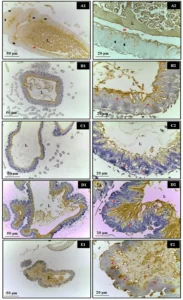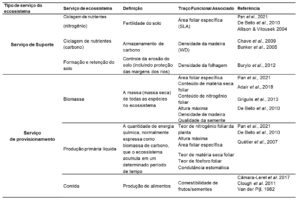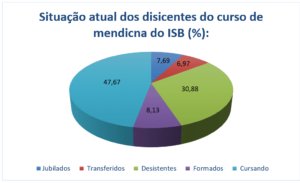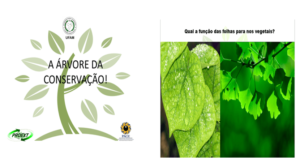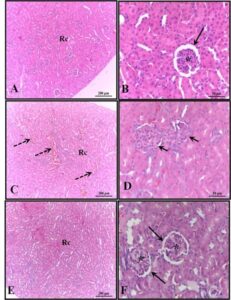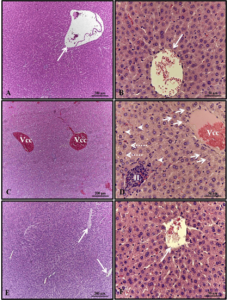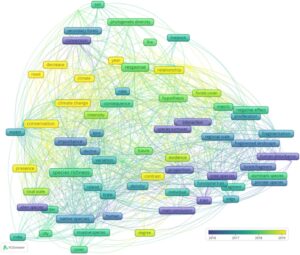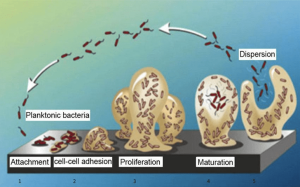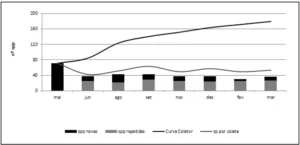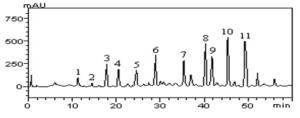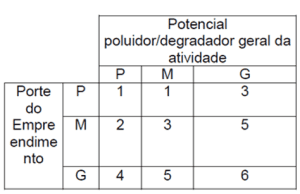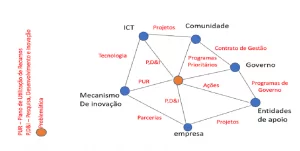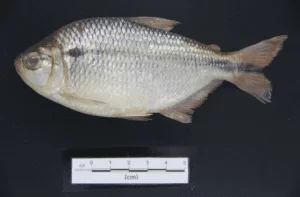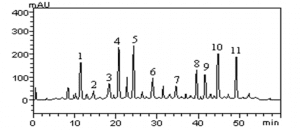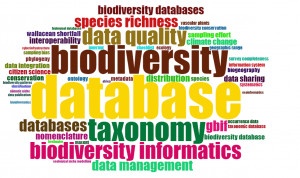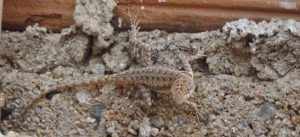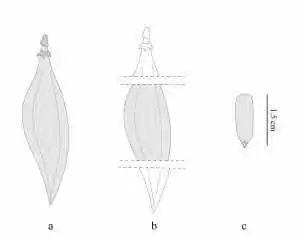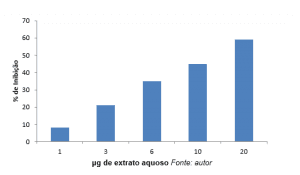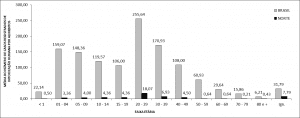REVIEW ARTICLE
RIBEIRO, Izabela Ferreira [1], MENEZES, Luis Fernando Tavares de [2], NASCIMENTO, Marcelo Trindade [3]
RIBEIRO, Izabela Ferreira. MENEZES, Luis Fernando Tavares de. NASCIMENTO, Marcelo Trindade. Facilitation between plants and the use of facilitating species as an ecological restoration strategy. Revista Científica Multidisciplinar Núcleo do Conhecimento. Year. 08, Ed. 03, Vol. 01, pp. 151-169. March 2023. ISSN: 2448-0959, Access link: https://www.nucleodoconhecimento.com.br/biology/ecological-restoration, DOI: 10.32749/nucleodoconhecimento.com.br/biology/ecological-restoration
ABSTRACT
Ecosystems subject to extreme abiotic factors are privileged places for studies of positive interactions between plants, such as facilitation mechanisms, which, from biotic or abiotic modifications, generate benefits to the environment. Due to the increase in the number of articles on facilitation in recent decades and the indication of the use of facilitating species in recovery and ecological restoration projects, the present study presents a literature review on facilitation between plant-plant and its applicability between the years 2011 and 2020. A total of 64 studies were considered that encompass the facilitation theme, and the text was composed of an introduction and two sections: i) studies on the facilitation mechanism – advances in the last decade and ii) facilitation as a strategy for ecological restoration. This review indicates that the best understanding of facilitation mechanisms occurs from the combination of knowledge at different levels, such as knowledge of species, ecological organization, phylogenetics and environmental conditions. Thus, this approach enables a better understanding of the community dynamics and demonstrates how the use of facilitating species in restoration areas, especially in regions with severe environmental conditions and/or more vulnerable to climate change, has been considered an effective strategy in the ecological restoration process.
Keywords: Extreme environments, Facilitation mechanism, Positive interactions.
1. INTRODUCTION
Facilitation mechanisms defined by positive interactions between plants allow that, on a time scale, benefits occur for one or both associated species (BRUNO; STACHOWICZ; BERTNESS, 2003; BROOKER et al., 2008; O’BRIEN et al., 2019). These interactions can occur due to environmental modifications, which favor the establishment or development of species (CALLAWAY, 1995; NAVARRO-CANO et al., 2015; ABIYU et al., 2017; LUCAS et al., 2022), as well as by other organisms , leading to increased pollination (LOSAPIO et al., 2021). The presence of a facilitator species allows the colonization of environments with low regeneration and extreme environmental conditions, positively modifying the dynamics and structure of the community, from the formation of microenvironments (PUGNAIRE; HAASE; PUIGDEFABREGAS, 1996; PUGNAIRE; ARMAS; MAESTRE , 2011; VALIENTE-BANUET; VERDÚ, 2013; MCINTIRE; FAJARDO, 2014; CAVIERES et al., 2016; LIANCOURT; DOLEZAL, 2021).
Studies of positive interactions between plant-plant began to be highlighted in the literature after the reviews by Bertness and Callaway (1994) and Callaway (1995), in which the topic began to be discussed and integrated into general models of dynamics and organization of the community. The study by Bertness and Callaway (1994) made it possible to clarify how positive interactions affect recruitment, the spatial distribution of species, reduce physical stress and consumer pressure, thus controlling the process of ecological succession. The authors formulated the Stress Gradient Hypothesis (SGH), in which they considered that the actions of facilitating species are intensified with an increase in the stress level. Callaway’s (1995) review, on the other hand, became a milestone in the facilitation theme, as it presented a table that brought together several studies produced since the early 1900s, expanding knowledge about the meaning of facilitation mechanisms and their role in communities. With these surveys, studies prior to the nineties gained visibility. Niering, Whittaker and Lowe (1963), for example, in a desert environment in Arizona, mentioned that species of different bushes, mainly “palo-verde” individuals, sheltered juveniles of “giant cacti” saguaros under their canopies, acting effectively for the survival and development of cacti. In this study, the term “nurse plant” (facilitating plants) was cited for the first time in the literature, designated for the perennial species that housed the cacti under their canopy. Other research carried out in the same environment confirmed the importance of the shade of the bushes for the survival of cactus individuals, and affirmed the term “nurse plant” for the “palo-verde” bushes, due to their ability to improve the development of cacti (HASTINGS; TURNER, 1965; TURNER et al., 1966). Connell and Slatyer (1977) expanded the knowledge about positive interactions, presenting a set of data on the dynamics of the community, raising questions about the processes of changes in the dynamics and ecological succession. These authors suggested three models of succession: tolerance, inhibition and facilitation, explaining how communities are formed and how they are modified over time.
Studies that contemplate this theme continued to be published, mainly from the 2000s, as mentioned by Brooker et al. (2008). Due to the presence of a facilitating individual, severe environmental conditions are alleviated (BANNISTER et al., 2020), allowing the understanding of the dynamics of communities (VEGA-ÁLVAREZ; GARCÍA-RODRÍGUEZ; CAYUELA, 2018; NAVARRO-CANO et al., 2019; LIANCOURT ; DOLEZAL, 2021), the use of facilitating species in ecological restoration projects has gained greater visibility, being considered an effective technique, as it reduces costs where human interventions, throughout the projects, are reduced by the benefits generated by the facilitating plant (HE; BERTNESS; ALTIERI, 2013; GÓMEZ-RUIZ; LINDIG-CISNEROS; VARGAS-RÍOS, 2013; SILLIMAN et al., 2015; SOLIVERES; SMIT; MAESTRE, 2015; ALDAY et al., 2016; FEDRIANI et al., 2019).
Thus, with a focus on a better understanding of the relationships between facilitating species and the dynamics of communities, where these processes occur, and the application of these species in environmental restoration projects in recent years, a literature review on these topics was carried out between 2011 and 2020.
2. MATERIAL AND METHODS
The search for publications was carried out, in December 2020, in four bibliographic bases: Web of Science, Scielo, ScienceDirect, Scopus and in a personal database. For each section, different words were searched, present in the title and/or in the keywords and/or in the abstract, which were redefined between 2011 and 2020. For the first section, the keywords were used: “facilitation mechanisms” and “vegetation” or “plant”, and in the second section, the keywords “facilitation”, “restoration” or “restored” and “vegetation” or “plant” were used.
A screening of the articles was carried out, in which repeated articles were excluded and articles directed to the themes were selected, based on their reading.
3. RESULTS
From a total of 1,811 publications, 64 publications were selected for analysis. After sorting and excluding repeated articles, the low number of articles that encompass the proposals of this study is evident. In the topic Studies on facilitation mechanisms – advances in the last decade, 28 out of 708 articles were used, and in the topic Facilitation, as a strategy for ecological restoration, 36 out of 592 were used.
3.1 STUDIES ON FACILITATION MECHANISMS – ADVANCES IN THE LAST DECADE
Review articles that evaluated studies on the facilitation mechanism in recent years confirm that positive interactions, such as facilitation between plants, can benefit community biodiversity by mitigating abiotic stresses, forming microhabitats and generating heterogeneity in the environment, especially in places under extreme environmental conditions (PUGNAIRE; ARMAS; MAESTRE, 2011; VALIENTE-BANUET; VERDÚ, 2013; CAVIERES et al., 2014; MCINTIRE; FAJARDO, 2014; CAVIERES et al., 2016; LIANCOURT; DOLEZAL, 2021). It is noteworthy that positive interactions also help in understanding biodiversity and ecosystem functioning, leading to an understanding of how diversity affects functions in a given environment (WRIGHT et al., 2017).
In recent years, publications that addressed the issue of facilitation between plant species were divided into bibliographic reviews and field evaluations. Bibliographic reviews focus on the evaluation of a particular species or a set of these, allowing a global understanding of the dynamics of a particular area and/or community, as seen in the article by Pugnaire, Armas and Maestre (2011). The authors brought together 15 years of studies carried out in desert areas of southeastern Spain, explaining the theme of positive interactions and their relationship with the community. Field evaluations are carried out by floristic surveys and experiments. With a focus on quantifying the abundance and richness of species with and/or without the presence of a possible facilitator, the floristic surveys aim to verify the occurrence of possible facilitation mechanisms, how they work and what are the implications of these for the species and for the environment (VAN ZONNEVELD; GUTIÉRREZ; HOLMGREN, 2012; BADANO et al., 2016; LYU et al., 2016; TSUDA; CASTELLANI, 2016; AL-NAMAZI; EL-BANA; BONSER, 2017; DALOTTO et al., 2018 ; FILAZZOLA et al., 2018; VEGA-ÁLVAREZ; GARCÍA-RODRÍGUEZ; CAYUELA, 2018; O’Brien et al., 2019; PELÁEZ et al., 2019). The second approach is the experiments, carried out by planting methodologies. In this approach, different techniques are used, such as the use of seeds (LIANCOURT; TIELBÖRGER, 2011; QUON; BOBICH; QUESTAD, 2019) and/or seedlings, with the inclusion of facilitating and/or facilitated species, in order to evaluate the facilitation mechanisms in isolated ways (AVENDAÑO-YÁÑEZ et al., 2014; VAN ZONNEVELD; GUTIÉRREZ; HOLMGREN, 2012; BADANO et al., 2016). It should be considered that, when the studies cited above are quantified, the predominance of observational studies stands out. This preference makes it difficult to identify facilitation processes and facilitating species, because field activities are considered more effective methodologies to identify facilitation mechanisms, due to the ability to evaluate and test (CASTANHO; OLIVEIRA; PRADO, 2015; CHAIEB et al., 2021).
Regardless of the technique used to describe facilitation processes and facilitating species, studies indicate that positive effects go beyond facilitating and benefiting other individuals. The evaluation of these effects allows answers about how the community dynamics occurs (VALIENTE-BANUET; VERDÚ, 2013; MCINTIRE; FAJARDO, 2014; WRIGHT et al., 2017; LIANCOURT; DOLEZAL, 2021) and how much diversity is changed, including functional diversity (LOSAPIO et al., 2021) and phylogenetic diversity (VALIENTE-BANUET; VERDÚ, 2013; VEGA-ÁLVAREZ; GARCÍA-RODRÍGUEZ; CAYUELA, 2018; DUARTE et al., 2021). Losapio et al. (2021) mention that facilitator plants increase the phylogenetic and functional diversity of floral visitors, indicating that facilitation mechanisms between plants can support ecosystem functioning, both directly (microhabitat improvement) and indirectly (diversity effects) . For the phylogenetic diversity of plants, Valiente-Banuet and Verdú (2013) cite that the maintenance of phylogenetic diversity can occur when species, in a given environment, have lineages with different evolutionary histories. Due to the optimal environment, there is a reduction in the process of competition and an increase in facilitation. Data cited by Duarte et al. (2021), in an experiment that sought to test SGH, where the authors describe a positive relationship between facilitation and elevation, mainly for species interactions with distant evolutionary lineages.
In addition to verifying the occurrence of facilitation in a given community, scientists seek to understand how this process is triggered and where it is more pronounced. Several authors use the SGH proposed by Bertness and Callaway (1994) as a basis for evaluating facilitation mechanisms (KIKVIDZE et al., 2011; BEDUSCHI; CASTELLANI, 2013; CAVIERES et al., 2014; MICHALET et al., 2014; LYU et al., 2016; AL-NAMAZI; EL-BANA; BONSER, 2017; O’BRIEN et al., 2019). Regarding environments with severe climatic conditions, different authors conclude that facilitation and competition mechanisms vary with climate change, and that environments with severe environmental conditions are positively related to facilitation mechanisms (KIKVIDZE et al., 2011; CAVIERES et al., 2014; AL-NAMAZI; EL-BANA; BONSER, 2017; O’BRIEN et al., 2019). The presence of a facilitator individual in these environments has an important effect on maintaining community diversity, in which facilitator species can alter climate filters, allowing the establishment and recruitment of species, increasing diversity and contributing to their distribution along these gradients, however, Michalet et al. (2014) warn that the evaluation of species composition related to the facilitation process and tested by the SGH approach can become complex. These authors cite that, at a certain threshold of climate change, processes such as the collapse of facilitation, the change from facilitation to competition and null mechanisms of interactions can occur. The collapse of facilitation may occur due to the decreasing effect of species facilitation, while the shift from facilitation to competition may be driven by environmental conditions and species response strategies, as corroborated by Liu et al. (2020). On the other hand, null mechanisms of interactions can occur in situations of extreme stress, in which environmental changes can directly interfere with interactions between plant species.
With the increase in the number of studies that consider plant-plant interactions, researchers have begun to correlate these processes with climate change. According to O’Brien et al. (2019), in some cases, facilitating species allowed greater survival of individuals in the face of increased temperatures, by offering shelter and more favorable conditions for the development of other individuals. Thus, the authors cite that the use of an individual that minimizes the effects of climate change, such as global warming, can create refuges for many individuals who, without assistance, will not be able to resist climate change.
3.2 FACILITATION AS A STRATEGY FOR ECOLOGICAL RESTORATION
With the increasing modification of natural environments around the world, motivated mainly by anthropization, the creation and development of techniques for the recovery of degraded areas have become essential (BURKE et al., 2011). Ecological restoration aims to form the necessary conditions for the restoration of the environment over the years, favoring abiotic and biotic flows in the matrix and making the environment not dependent on long-term human interventions (TEMPERTON et al., 2004; SER, 2023 ), and began to be inserted in recovery projects in the mid-twentieth century, in which different strategies and techniques were created and tested over the years (BRANCALION et al., 2015; SER, 2023), such as the use of biotic interactions. Among biotic interactions, the use of facilitating species (e.g., positive interactions between plant species) has been tested and considered an effective strategy.
A facilitating species can lead to a reduction in the physiological stress of plant individuals, by mitigating extreme environmental conditions (BANNISTER et al., 2020), and can make the soil more nutritious (NAVARRO-CANO et al., 2015; ABIYU et al., 2017 ), inhibit the growth of exotic species cover (MARTINEZ; DORNBUSH, 2013; GALINDO et al., 2017), increase the local fauna (LOSAPIO et al., 2021), form seed banks below the canopy (ERFANZADEH; PALAYE; GHELICHNIA, 2020; FORONDA et al., 2020), allow germination (FEDRIANI et al., 2019) (Figure 1: A-B), survival and growth of plant species (URRETAVIZCAYA; DEFOSSÉ, 2013; ENCINO-RUIZ et al., 2013; DOMÍNGUEZ et al., 2015; TORROBA-BALMORI et al., 2015; SUN et al., 2017) (Figure 1: C). Thus, in environmental restoration projects, facilitating individuals allow cost reduction in projects, by positively modifying the community and making the environment more favorable for the development of other individuals, without the need for major human interventions (HE; BERTNESS; ALTIERI, 2013; GÓMEZ-RUIZ; LINDIG-CISNEROS; VARGAS-RÍOS, 2013; SILLIMAN et al., 2015; SOLIVERES; SMIT; MAESTRE, 2015; ALDAY et al., 2016; FEDRIANI et al., 2019).
Biotic interactions are more frequently used in restoration projects in environments with extreme conditions, with less regeneration capacity, mainly due to abiotic factors (MENDOZA-HERNÁNDEZ et al., 2013; CASTANHO; OLIVEIRA; PRADO, 2015, SER, 2023). However, the inclusion of biotic interactions in restoration projects in mild environmental conditions, such as areas of Atlantic forest and riparian forest, should be considered. When forest areas undergo deforestation, drastic environmental changes occur that generate an imbalance in the environment, making the use of positive interactions an appropriate technique (ANTHELME; GÓMEZ-APARICIO; MONTÚFAR, 2014; AVENDAÑO-YÁÑEZ et al., 2014; LAMEIRA et al., 2019; PEREA et al., 2019). It should be considered that, in certain arid areas, under severe drought conditions, with high water stress, the positive effects can be suppressed by competition (JANKJU, 2013; NOUMI et al., 2015), or will simply fail, indicating that this tool can be limited by the climate (MICHALET et al., 2014; GONZALEZ; GHERMANDI, 2019).
The assessment of the functional (NAVARRO-CANO et al., 2019), taxonomic and phylogenetic identity of facilitating and facilitated species is important to enhance the use of this technique, and has been shown to be relevant in the results of interactions in restoration experiments (VERDÚ; NUMA; HERNÁNDEZ-CUBA, 2011; NAVARRO-CANO et al., 2016). It is noticed that, the greater the phylogenetic distance between species, the more they tend to present different phenotypes, therefore, different ecological requirements, reducing competition and maximizing the facilitation effect (VERDÚ; NUMA; HERNÁNDEZ-CUBA, 2011; VERDÚ; GÓMEZ-APARICIO; VALIENTE-BANUET, 2012). The same occurs with the functional distance (morphological and physiological characteristics), in which, the greater the functional distance between the facilitator and the facilitated species, the greater the success of seedling establishment (NAVARRO-CANO et al., 2019). However, it should be considered that facilitating species do not necessarily open the way to benefit all species (LORTIE, 2017), soil preparation, choice of species and selection of seedlings being also relevant for the efficient recovery of the environment (DIAS et al., 2014).
Finally, it should be considered that, although there are several studies that cite the use of facilitating species as alternatives in ecological restoration, few of them, especially in recent years, have carried out experiments in the field, proving the efficiency of using these species in restoration projects (Chart 1).
Table 1- Advances in research on the use of facilitating species in ecological recovery and restoration projects in the last three years, with examples of articles, including their authors, titles and main results
| Authors | Article title | Abstract |
| Bannister et al. (2020) | Shrub influences on seedling performance when restoring the slow-growing conifer Pilgerodendron
uviferum in southern bog forests. |
In an experiment to evaluate the recovery of Pilgerodendron uviferum (D. Don) Florin. in swampy forests in Chile. The authors evaluated, for four years, the presence and absence of shrubs in the development of the species, and indicated that the presence of shrubs generated a reduction in the physiological stress of P. uviferum individuals (measured as Fv/Fm), as well as greater height increase and greater vitality. |
| Foronda et al. (2020) | Substrate-specialist plants for restoring vegetation in post-mining gypsum substrates. | The authors evaluated the facilitating role of Gypsophila struthium Loefl. on the germination and development of species in a rubbish dump in Spain. As a result, the species was considered a pioneer shrub in the mine, increasing local diversity and having a positive effect on seed germination, individual growth, soil improvement and forming microhabitats under its canopy. |
| Fedriani et al. (2020) | Combined effect of seed provenance, plant facilitation and restoration site on revegetation success. | This study evaluated the facilitator potential of three shrub species for Pyrus bourgaeana Decne, in an area undergoing environmental restoration in Spain. As a result, it was observed that, although shrubs have a positive effect on P. bourgaeana, the magnitude of interactions changes both with the sowing location and with the provenance of the seeds. |
| Gonzalez and Ghermandi (2019) | Dwarf shrub facilitates seedling recruitment and plant diversity in semiarid grasslands. | The richness, seedling emergence and survival of Festuca pallescens (St.-Yves) Parodi were evaluated with and without the presence of Acaena splendens, in an area of northwest Patagonia. In the results, the indices were higher with the presence of A. splendens, however, the seedlings died in the summer in both microsites, indicating that A. splendens acts as a kind of facilitator, however, the facilitation mechanism can fail in conditions drought, indicating that it is a climate-limited restoration tool. |
| Martelletti et al. (2018) | Microsite manipulation in lowland oak forest restoration results in indirect effects on a corn predation. | The study that investigated Cytisus scoparius (L.) Link. and artificial shade structures, as possible facilitation mechanisms, with and without prior soil improvement, in seed emergence and predation, in northern Italy, found no evidence of direct facilitation in emergence, however, indirect effects were detected in the form of seed predation, which were negatively affected by the presence of C. scoparius. |
Source: Author.
Figure 1 – Clusia hilariana Schltdl. in the rosette of the tank bromeliad Aechmea blanchetiana (Baker) LB Sm.: (A-B) Germination of C. hilariana in the rosette of the tank bromeliad; (C) Growth of C. hilariana in the tank bromeliad rosette
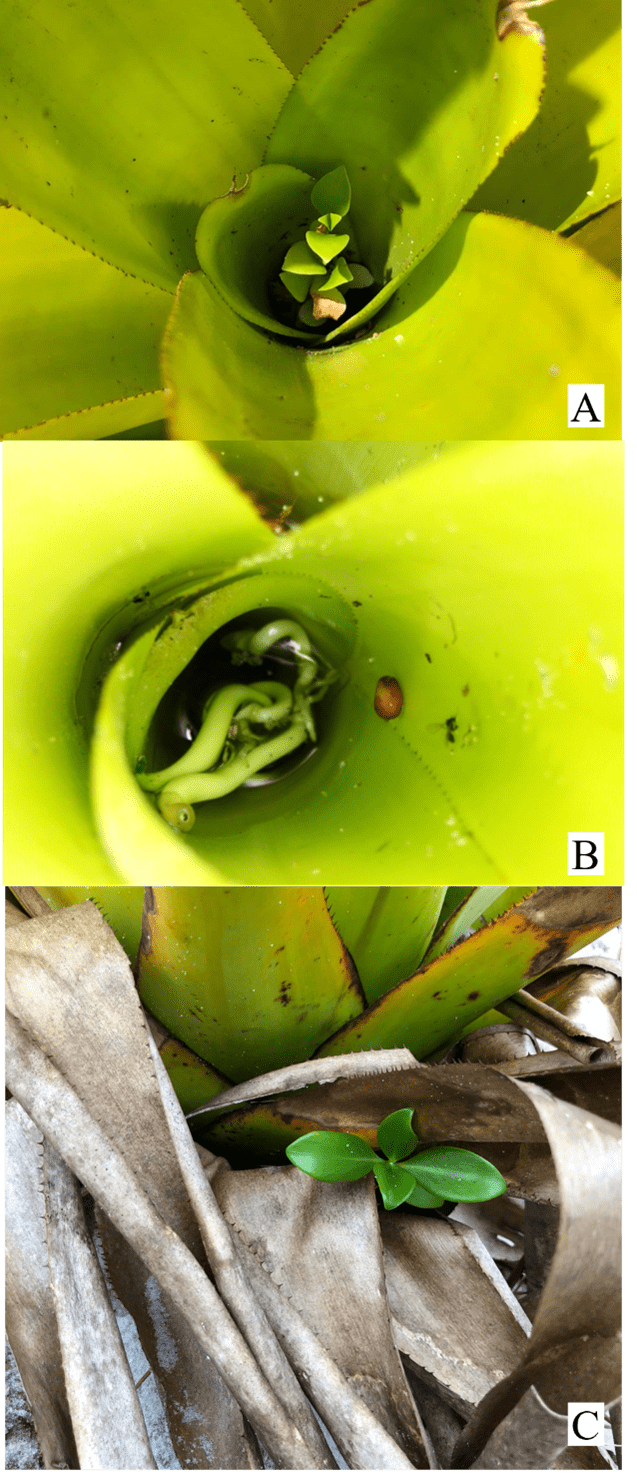
4. FINAL CONSIDERATIONS
This review highlights the importance of knowledge about the environment and climatic conditions for a better understanding of facilitation processes, as well as the responses of facilitating and facilitated species.
The articles selected in this study highlight the positive role of facilitating plants in community dynamics, both ecologically and phylogenetically, and understanding the efficiency of using facilitating species in restoration projects for degraded areas. It is noteworthy that most of the cited studies are considered observational, and a small number of these were developed with planting methodologies. These data, together with the existence of gray literature (e.g., theses, dissertations, technical reports, unpublished data), generate gaps in the knowledge of the processes evaluated here.
ACKNOWLEDGMENT
This work was carried out with the support of the Coordenação de Aperfeiçoamento de Pessoal de Nível Superior – Brasil (CAPES) – Financing Code 001, the Fundação Carlos Chagas Filho de Amparo à Pesquisa do Estado do Rio de Janeiro (FAPERJ) and the Support Fundação de Amparo à Pesquisa e Inovação do Espírito Santo (FAPES). Marcelo Trindade Nascimento has the support of the Conselho Nacional de Desenvolvimento Científico e Tecnológico do Brasil (CNPq: 305617/2018-4) and the Fundação Carlos Chagas Filho de Amparo à Pesquisa do Estado do Rio de Janeiro (FAPERJ E-26/202.855/2018).
REFERENCES
ABIYU, Abrham et al. Restoration of degraded ecosystems in the Afromontane highlands of Ethiopia: comparison of plantations and natural regeneration. Southern Forests: a Journal of Forest Science, v. 79, n. 2, p. 103-108, 2017.
ALDAY, Josu G. et al. Natural forest expansion on reclaimed coal mines in Northern Spain: the role of native shrubs as suitable microsites. Environmental Science and Pollution Research, v. 23, p. 13606-13616, 2016.
AL‐NAMAZI, Ali A.; EL‐BANA, Magdy I.; BONSER, Stephen P. Competition and facilitation structure plant communities under nurse tree canopies in extremely stressful environments. Ecology and Evolution, v. 7, n. 8, p. 2747-2755, 2017.
ANTHELME, Fabien; GÓMEZ‐APARICIO, Lorena; MONTÚFAR, Rommel. Nurse‐based restoration of degraded tropical forests with tussock grasses: experimental support from the Andean cloud forest. Journal of Applied Ecology, v. 51, n. 6, p. 1534-1543, 2014.
AVENDAÑO-YÁÑEZ, María de la Luz et al. Is facilitation a promising strategy for cloud forest restoration? Forest Ecology and Management, v. 329, p. 328-333, 2014.
BADANO, Ernesto I. et al. Facilitation by nurse plants contributes to vegetation recovery in human-disturbed desert ecosystems. Journal of Plant Ecology, v. 9, n. 5, p. 485-497, 2016.
BANNISTER, Jan R. et al. Shrub influences on seedling performance when restoring the slow‐growing conifer Pilgerodendron uviferum in southern bog forests. Restoration Ecology, v. 28, n. 2, p. 396-407, 2020.
BEDUSCHI, Tatiane; CASTELLANI, Tânia Tarabini. Friends or Foes? Interplay of facilitation and competition depends on the interaction between abiotic stress and ontogenetic stage. Plant ecology, v. 214, p. 1485-1492, 2013.
BERTNESS, Mark D.; CALLAWAY, Ragan. Positive interactions in communities.
Trends in ecology & evolution, v. 9, n. 5, p. 191-193, 1994.
BRANCALION, Pedro Henrique Santin et al. Avaliação e monitoramento de áreas em processo de restauração. In: MARTINS,Sebastião Venâncio. Restauração ecológica de ecossistemas degradados. Viçosa: Editora UFV, 2015, p.262-291.
BROOKER, Rob W. et al. Facilitation in plant communities: the past, the present, and the future. Journal of Ecology, v. 96, n. 1, p. 18-34, 2008.
BRUNO, John F.; STACHOWICZ, John J.; BERTNESS, Mark D. Inclusion of facilitation into ecological theory. Trends in ecology & evolution, v. 18, n. 3, p. 119-125, 2003.
BURKE, Lauretta et al. Reefs at risk revisited. Washington: World Resources Institute, 2011.
CALLAWAY, Ragan M. Positive interactions among plants. The Botanical Review, v. 61, p. 306-349, 1995.
CASTANHO, Camila T.; OLIVEIRA, Alexandre A.; PRADO, Paulo Inácio K. L. Does extreme environmental severity promote plant facilitation? An experimental field test in a subtropical coastal dune. Oecologia, v. 178, p. 855-866, 2015.
CAVIERES, Lohengrin A. et al. Facilitative plant interactions and climate simultaneously drive alpine plant diversity. Ecology letters, v. 17, n. 2, p. 193-202, 2014.
CAVIERES, Lohengrin A. et al. Facilitation among plants as an insurance policy for diversity in Alpine communities. Functional Ecology, v. 30, n. 1, p. 52-59, 2016.
CHAIEB, Ghassen et al. Shift from short‐term competition to facilitation with drought stress is due to a decrease in long‐term facilitation. Oikos, v. 130, n. 1, p. 29-40, 2021.
CONNELL, Joseph H.; SLATYER, Ralph O. Mechanisms of succession in natural communities and their role in community stability and organization. The American Naturalist, v. 111, n. 982, p. 1119-1144, 1977.
DALOTTO, Cecilia E. S. et al. Facilitation influences patterns of perennial species abundance and richness in a subtropical dune system. AoB Plants, v. 10, n. 2, p. ply017, 2018.
DIAS, André Tavares Corrêa et al. Limited relevance of studying colonization in degraded areas for selecting framework species for ecosystem restoration. Natureza & Conservação, v. 12, n. 2, p. 134-137, 2014.
DOMÍNGUEZ, María T. et al. Facilitating the afforestation of Mediterranean polluted soils by nurse shrubs. Journal of Environmental Management, v. 161, p. 276-286, 2015.
DUARTE, Milen et al. Plant–plant facilitation increases with reduced phylogenetic relatedness along an elevation gradient. Oikos, v. 130, n. 2, p. 248-259, 2021.
ENCINO-RUIZ, Limberg et al. Performance of three tree species from tropical dry forest in an ecological restoration trial. Botanical Sciences, v. 91, n. 1, p. 107-114, 2013.
ERFANZADEH, Reza; PALAYE, Ali A. Shayesteh; GHELICHNIA, Hassan. Shrub effects on germinable soil seed bank in overgrazed rangelands. Plant Ecology & Diversity, v. 13, n. 2, p. 199-208, 2020.
FEDRIANI, Jose M. et al. The overlooked benefits of synzoochory: rodents rescue seeds from aborted fruits. Ecosphere, v. 11, n. 11, p. e03298, 2020.
FILAZZOLA, Alessandro et al. The effect of consumer pressure and abiotic stress on positive plant interactions are mediated by extreme climatic events. New Phytologist, v. 217, n. 1, p. 140-150, 2018.
FORONDA, Ana et al. The role of shrubs in spatially structuring the soil seed bank of perennial species in a semi-arid gypsum plant community. Plant Ecology, v. 221, p. 913-923, 2020.
GALINDO, Víctor et al. Facilitation by pioneer shrubs for the ecological restoration of riparian forests in the Central Andes of Colombia. Restoration Ecology, v. 25, n. 5, p. 731-737, 2017.
GÓMEZ-RUIZ, Pilar Angélica; LINDIG-CISNEROS, Roberto; VARGAS-RÍOS, Orlando. Facilitation among plants: A strategy for the ecological restoration of the high-andean forest (Bogotá, DC – Colombia). Ecological Engineering, v. 57, p. 267-275, 2013.
GONZALEZ, Sofia L.; GHERMANDI, Luciana. Dwarf shrub facilitates seedling recruitment and plant diversity in semiarid grasslands. PloS one, v. 14, n. 2, p. e0212058, 2019.
HASTINGS, James Rodney; TURNER, Raymond M. The changing mile: an ecological study of vegetation change with time in the lower mile of an arid and semiarid region. Tucson: University of Arizona Press, 1965.
HE, Qiang; BERTNESS, Mark D.; ALTIERI, Andrew H. Global shifts towards positive species interactions with increasing environmental stress. Ecology letters, v. 16, n. 5, p. 695-706, 2013.
JANKJU, Mohammad. Role of nurse shrubs in restoration of an arid rangeland: Effects of microclimate on grass establishment. Journal of Arid Environments, v. 89, p. 103-109, 2013.
KIKVIDZE, Zaal et al. Climatic drivers of plant–plant interactions and diversity in alpine communities. Alpine Botany, v. 121, p. 63-70, 2011.
LAMEIRA, Lohana Lopes et al. Plant-canopy effects on natural regeneration in sites under restoration: do tree species matter? Floresta e Ambiente, v. 26, n.1, p. e20180398, 2019.
LIANCOURT, Pierre; DOLEZAL, Jiri. Community‐scale effects and strain: facilitation beyond conspicuous patterns. Journal of Ecology, v. 109, n. 1, p. 19-25, 2021.
LIANCOURT, Pierre; TIELBÖRGER, Katja. Ecotypic differentiation determines the outcome of positive interactions in a dryland annual plant species. Perspectives in Plant Ecology, Evolution and Systematics, v. 13, n. 4, p. 259-264, 2011.
LORTIE, Christopher J. Fix‐it Felix: advances in testing plant facilitation as a restoration tool. Applied Vegetation Science, v. 20, n. 3, p. 315-316, 2017.
LOSAPIO, Gianalberto et al. An experimental approach to assessing the impact of ecosystem engineers on biodiversity and ecosystem functions. Ecology, v. 102, n. 2, p. e03243, 2021.
LUCAS, Diego Sales et al. Evidence of facilitation between early‐successional tree species and the regenerating plant community in a tropical seasonally dry environment. Austral Ecology, v. 47, n. 3, p. 541-556, 2022.
LYU, Lixin et al. Fine-scale distribution of treeline trees and the nurse plant facilitation on the eastern Tibetan Plateau. Ecological indicators, v. 66, p. 251-258, 2016.
MARTELLETTI, Sara et al. Microsite manipulation in lowland oak forest restoration results in indirect effects on acorn predation. Forest Ecology and Management, v. 411, p. 27-34, 2018.
MARTINEZ, Joshua A.; DORNBUSH, Mathew E. Use of a native matrix species to facilitate understory restoration in an overbrowsed, invaded woodland. Invasive Plant Science and Management, v. 6, n. 2, p. 219-230, 2013.
MCINTIRE, Eliot J. B.; FAJARDO, Alex. Facilitation as a ubiquitous driver of biodiversity. New phytologist, v. 201, n. 2, p. 403-416, 2014.
MENDOZA-HERNÁNDEZ, Pedro E. et al. Vegetation recovery and plant facilitation in a human-disturbed lava field in a megacity: searching tools for ecosystem restoration.
Plant Ecology, v. 214, p. 153-167, 2013.
MICHALET, Richard et al. Two alternatives to the stress‐gradient hypothesis at the edge of life: the collapse of facilitation and the switch from facilitation to competition. Journal of Vegetation Science, v. 25, n. 2, p. 609-613, 2014.
NAVARRO-CANO, Jose Antonio et al. What nurse shrubs can do for barren soils: rapid productivity shifts associated with a 40 years ontogenetic gradient. Plant and Soil, v. 388, p. 197-209, 2015.
NAVARRO‐CANO, Jose Antonio. et al. Restoring phylogenetic diversity through facilitation. Restoration Ecology, v. 24, n. 4, p. 449-455, 2016.
NAVARRO‐CANO, Jose Antonio et al. Additive effects of nurse and facilitated plants on ecosystem functions. Journal of Ecology, v. 107, n. 6, p. 2587-2597, 2019.
NIERING, W. A.; WHITTAKER, R. H.; LOWE, C. H. The Saguaro: a population in relation to environment: reproduction and survival are more affected by man’s intrusion than by environmental extremes. Science, v. 142, n. 3588, p. 15-23, 1963.
NOUMI, Zouhaier et al. Limitations to the use of facilitation as a restoration tool in arid grazed savanna: a case study. Applied Vegetation Science, v. 18, n. 3, p. 391-401, 2015.
O’BRIEN, Michael J. et al. Facilitation mediates species presence beyond their environmental optimum. Perspectives in plant ecology, evolution and systematics, v. 38, p. 24-30, 2019.
PELÁEZ, Marta et al. Nurse plant size and biotic stress determine quantity and quality of plant facilitation in oak savannas. Forest Ecology and Management, v. 437, p. 435-442, 2019.
PEREA, Ramón et al. Nurse shrubs to mitigate plant invasion along roads of montane Neotropics. Ecological Engineering, v. 136, p. 193-196, 2019.
PUGNAIRE, Francisco I.; ARMAS, C.; MAESTRE, F. T. Positive plant interactions in the Iberian Southeast: mechanisms, environmental gradients, and ecosystem function. Journal of Arid Environments, v. 75, n. 12, p. 1310-1320, 2011.
PUGNAIRE, Francisco I.; HAASE, Peter; PUIGDEFABREGAS, Juan. Facilitation between higher plant species in a semiarid environment. Ecology, v. 77, n. 5, p. 1420-1426, 1996.
QUON, Lauren H.; BOBICH, Edward G.; QUESTAD, Erin J. Facilitation and herbivory during restoration of California coastal sage scrub. Restoration Ecology, v. 27, n. 5, p. 1041-1052, 2019.
SER – Society for Ecological Restoration. What is ecological restoration? Society for Ecological Restoration, 2023. Disponível em: https://www.ser-rrc.org/what-is-ecological-restoration/. Acesso em: 10 jun. 2020.
SILLIMAN, Brian R. et al. Facilitation shifts paradigms and can amplify coastal restoration efforts. Proceedings of the National Academy of Sciences, v. 112, n. 46, p. 14295-14300, 2015.
SOLIVERES, Santiago; SMIT, Christian; MAESTRE, Fernando T. Moving forward on facilitation research: response to changing environments and effects on the diversity, functioning and evolution of plant communities. Biological Reviews, v. 90, n. 1, p. 297-313, 2015.
SUN, Zhongyu et al. Plantation age, understory vegetation, and species‐specific traits of target seedlings alter the competition and facilitation role of eucalyptus in South China.
Restoration Ecology, v. 25, n. 5, p. 749-758, 2017.
TEMPERTON, Vicky M. et al. Assembly rules and restoration ecology: bridging the gap between theory and practice. Washington, DC: Island Press, 2004.
TORROBA-BALMORI, Paloma et al. Recovering Quercus species on reclaimed coal wastes using native shrubs as restoration nurse plants. Ecological engineering, v. 77, p. 146-153, 2015.
TSUDA, Érika Tiemi; CASTELLANI, Tânia Tarabini. Vriesea friburgensis: a natural trap or a nurse plant in coastal sand dunes? Austral Ecology, v. 41, n. 3, p. 273-281, 2016.
TURNER, Raymond M. et al. The influence of shade, soil, and water on saguaro seedling establishment. Botanical Gazette, v. 127, n. 2/3, p. 95-102, 1966.
URRETAVIZCAYA, María Florencia; DEFOSSÉ, Guillermo E. Effects of nurse shrubs and tree shelters on the survival and growth of two Austrocedrus chilensis seedling types in a forest restoration trial in semiarid Patagonia, Argentina. Annals of Forest Science, v. 70, n. 1, p. 21-30, 2013.
VALIENTE-BANUET, Alfonso; VERDÚ, Miguel. Plant facilitation and phylogenetics.
Annual Review of Ecology, Evolution, and Systematics, v. 44, p. 347-366, 2013.
VAN ZONNEVELD, Maarten J.; GUTIÉRREZ, Julio R.; HOLMGREN, Milena. Shrub facilitation increases plant diversity along an arid scrubland–temperate rain forest boundary in South America. Journal of Vegetation Science, v. 23, n. 3, p. 541-551, 2012.
VEGA‐ÁLVAREZ, Julia; GARCÍA‐RODRÍGUEZ, José Antonio; CAYUELA, Luis. Facilitation beyond species richness. Journal of Ecology, v. 107, n. 2, p. 722-734, 2018.
VERDÚ, José R.; NUMA, Catherine; HERNÁNDEZ-CUBA, Olmo. The influence of landscape structure on ants and dung beetles diversity in a Mediterranean savana – Forest ecosystem. Ecological Indicators, v. 11, n. 3, p. 831-839, 2011.
VERDÚ, Miguel; GÓMEZ-APARICIO, Lorena; VALIENTE-BANUET, Alfonso. Phylogenetic relatedness as a tool in restoration ecology: a meta-analysis. Proceedings of the Royal Society B: Biological Sciences, v. 279, n. 1734, p. 1761-1767, 2012.
WRIGHT, Alexandra J. et al. The overlooked role of facilitation in biodiversity experiments. Trends in Ecology & Evolution, v. 32, n. 5, p. 383-390, 2017
[1] Master in Tropical Biodiversity. Laboratory of Environmental Sciences, Universidade Estadual Norte Fluminense Darcy Ribeiro, UENF, Parque California, 28013–602, Campos dos Goytacazes, Rio de Janeiro, Brazil. [email protected]. ORCID: 0000-0002-4868-6369. CURRICULUM LATTES: http://lattes.cnpq.br/7186707603292907.
[2] Co-advisor. PhD in Ecology (UFRJ). Postdoctoral fellow at the Federal University of Rio de Janeiro and Estacion Experimental de Zonas Áridas – Spain (CAPES Scholarship). Department of Agricultural and Biological Sciences, Federal University of Espírito Santo, 29932-540, São Mateus-ES, Brazil. ORCID: 0000-0003-1854-2441. LATTES CURRICULUM: http://lattes.cnpq.br/4502113593775550.
[3] Advisor. Doctorate in Ecology, PhD, from the University of Stirling, Scotland in 1994 and Postdoctoral fellow at the Royal Botanic Garden Edinburgh in 2013. Laboratory of Environmental Sciences, Universidade Estadual Norte Fluminense Darcy Ribeiro, UENF, Parque California, 28013–602, Campos dos Goytacazes , Rio de janeiro Brazil. ORCID: 0000-0003-4492-3344. LATTES CURRICULUM: http://lattes.cnpq.br/3704305950005564.
Submitted: February 07, 2023.
Approved: February 23, 2023.

